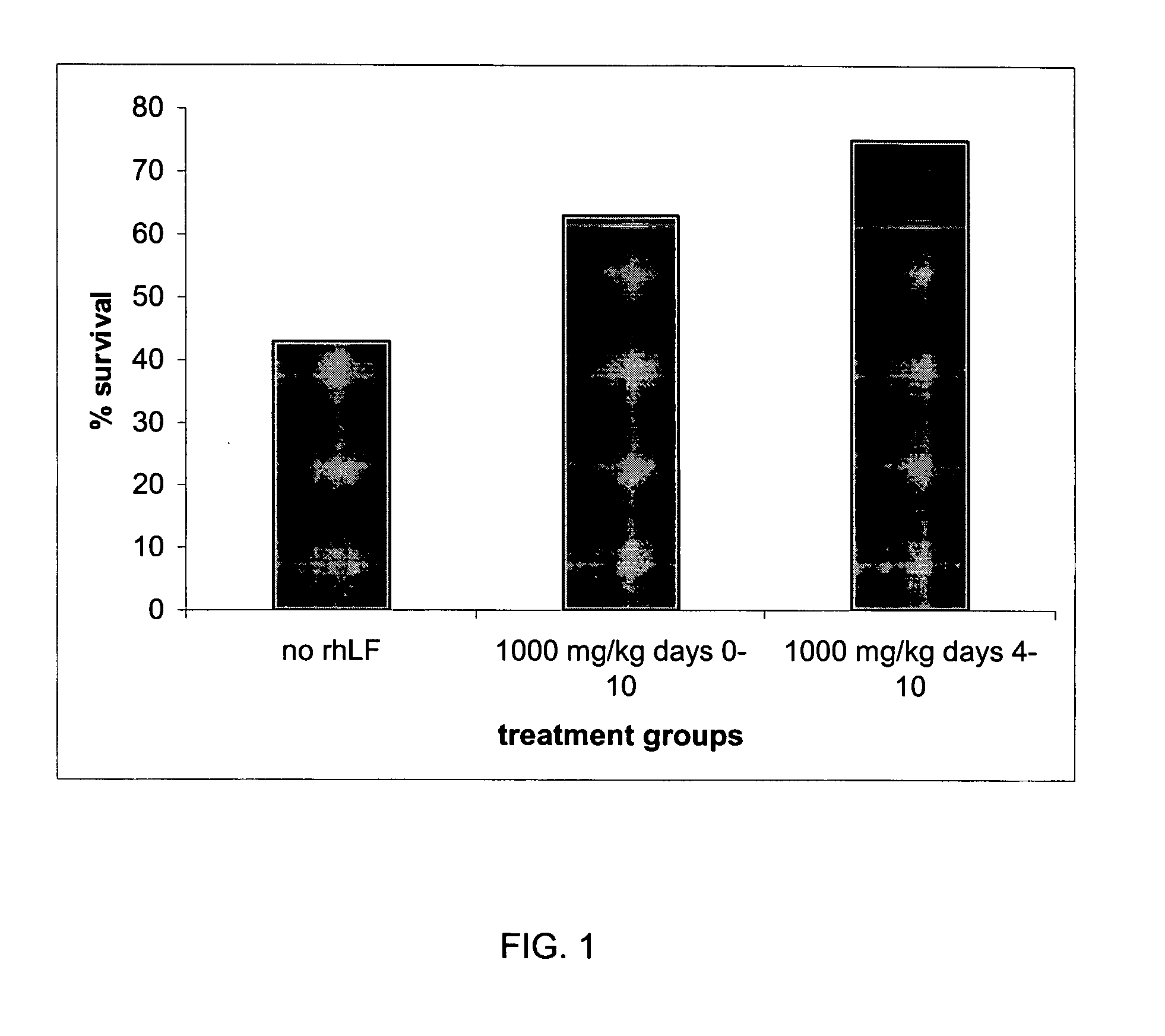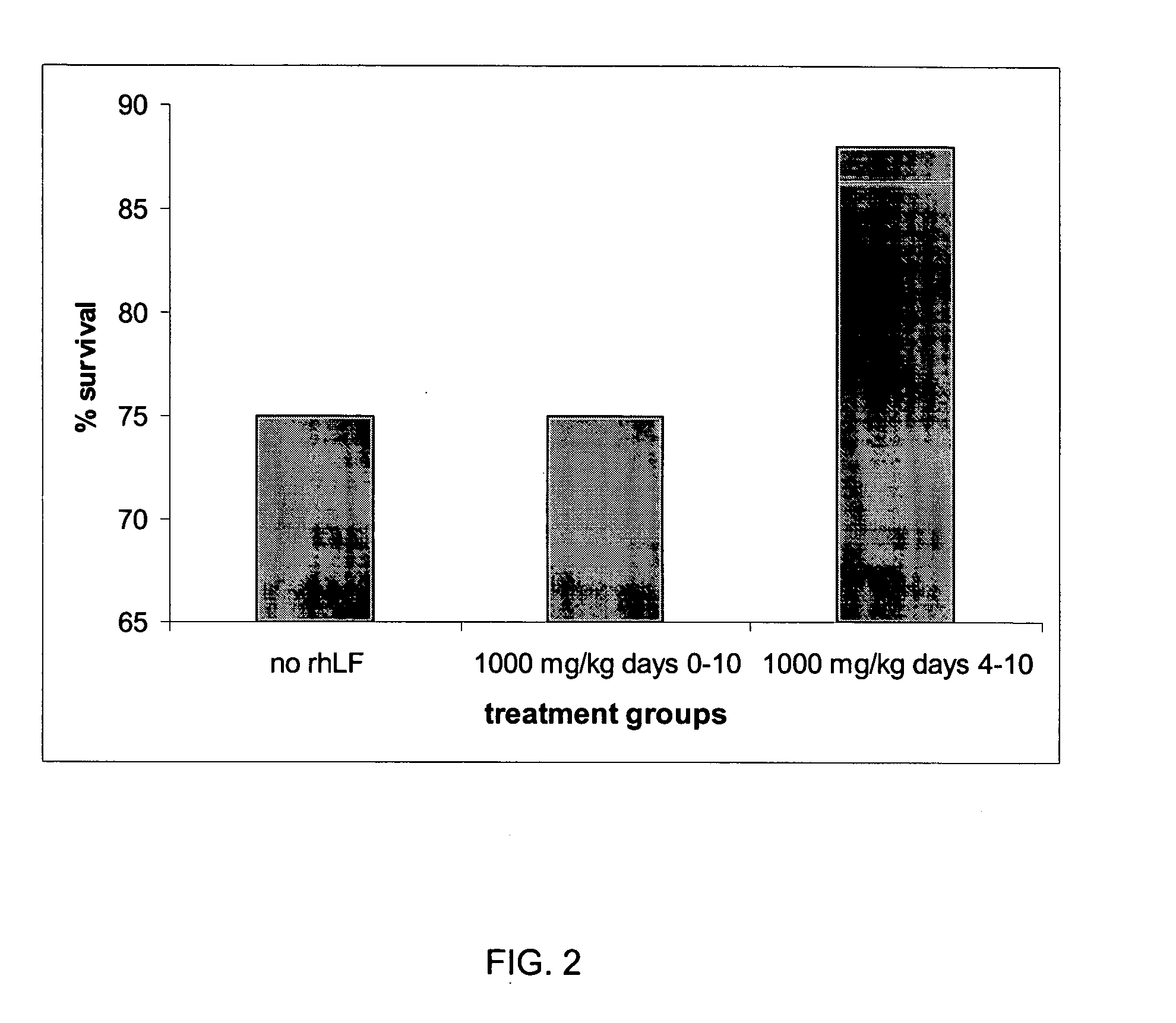Use of lactoferrin in prophylaxis against infection and/or inflammation in immunosuppressed subjects
a technology of immunosuppressed subjects and lactoferrin, which is applied in the direction of transferrins, drug compositions, peptide/protein ingredients, etc., can solve the problems of mainly palliative and not therapeutic treatment of mucositis, increased risk of infection and/or inflammation in cancer patients undergoing aggressive chemotherapy and radiotherapy, and increased risk of generalized inflammation. , to achieve the effect of reducing the severity of infection and/or inflammation, prolonging the period
- Summary
- Abstract
- Description
- Claims
- Application Information
AI Technical Summary
Benefits of technology
Problems solved by technology
Method used
Image
Examples
example 1
Use of rhLF in Stem Cell Recipients
[0098] This example describes a prophylactic administration of rhLF in patients receiving autologous bone marrow transplants to prevent or reduce the incidence, duration, and severity of neutropenia and / or mucositis in this patient population.
[0099] Patients enrolled were 18 years or older who were receiving high dose chemotherapy prior to autologous bone marrow transplant, and expected to have a >50% incidence of grade ¾ neutropenia, and >40% incidence of grade ¾ oral mucositis. Patients were treated prophylactically with rhLF or placebo.
[0100] The dosing regime for rhLF or vehicle was begun via oral administration within 24 hours of the initiation of the conditioning regimen and continued for up to 28 days. RHLF was provided as a 100 mg / mL solution in a phosphate buffer (pH=7.0+0.1), in individual 15 mL unit doses. One vial (1.5 g of rhLF or a vehicle control) was administered 3 times a day at least 1 hour before meals or other oral intake, fo...
example 2
Use of rhLF in Myelosuppressive Chemotherapy
[0103] This example describes a the use of rhLF in patients undergoing myelosuppressive chemotherapy.
[0104] Adult patients who experience neutropenic fever (temperature>38.3 with ANC3) in a previous cycle of chemotherapy and are to receive the same regimen at the same dose in the next cycle selected to receive lactoferrin treatment.
[0105] Briefly, four cohorts are recruited, with two placebo and eight actively treated subjects in each cohort. Each cohort receives 0.5 g, 1.0 g., 1.5 g or 2.0 g drug (or placebo) tid for a total daily dose of 1.5 g, 3 g, 4.5 g or 6 g rhLF. Administration of rhLF or placebo starts the day after the completion of chemotherapy and continue through the neutropenic phase until an absolute neutrophil count of 1,500 / mm3 is reached or exceeded for two consecutive days.
[0106] Clinical parameters that are tested include, physical examination (including vital signs, height, weight); temperature (three times a day); ...
example 3
Use of rhLF to Treat Mucositis
[0107] This example describes the use of rhLF in reducing the incidence of patients developing mucositis as a result of aggressive radiation therapy for the treatment of cancer.
[0108] Four cohorts are recruited, with two placebos and eight actively treated subjects in each cohort. Cohorts receives 0.5 g, 1.0 g, 1.5 g or 2.0 g drug (or placebo) tid (3 times a day) for a total daily dose of 1.5 g, 3 g, 4.5 g or 6 g rhLF. Administration of rhLF or placebo starts the day after the completion of radiation therapy and continue for 21 days.
[0109] Patients are asked to swish the rhLF or placebo solution in their mouths for 4 minutes to coat the buccal mucosa, gargle and swallow the liquid preparation three times a day.
[0110] Primary endpoints are incidence, duration and severity of oral mucositis by subjective (patient questionnaire) and objective (OMAS scale) criteria. Patients are monitored according to standard clinical and laboratory parameters includin...
PUM
| Property | Measurement | Unit |
|---|---|---|
| pH | aaaaa | aaaaa |
| concentration | aaaaa | aaaaa |
| temperature | aaaaa | aaaaa |
Abstract
Description
Claims
Application Information
 Login to View More
Login to View More - R&D
- Intellectual Property
- Life Sciences
- Materials
- Tech Scout
- Unparalleled Data Quality
- Higher Quality Content
- 60% Fewer Hallucinations
Browse by: Latest US Patents, China's latest patents, Technical Efficacy Thesaurus, Application Domain, Technology Topic, Popular Technical Reports.
© 2025 PatSnap. All rights reserved.Legal|Privacy policy|Modern Slavery Act Transparency Statement|Sitemap|About US| Contact US: help@patsnap.com


